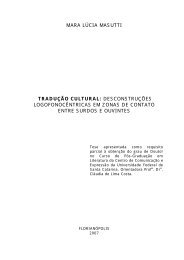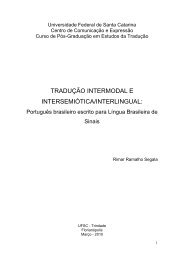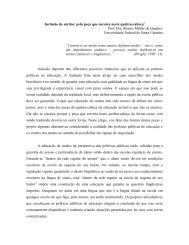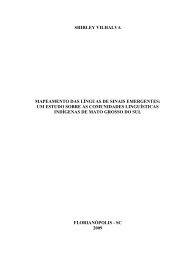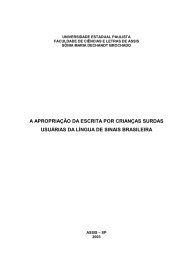Phrase Structure of Brazilian Sign Language - Ronice.cce.prof.ufsc.br
Phrase Structure of Brazilian Sign Language - Ronice.cce.prof.ufsc.br
Phrase Structure of Brazilian Sign Language - Ronice.cce.prof.ufsc.br
You also want an ePaper? Increase the reach of your titles
YUMPU automatically turns print PDFs into web optimized ePapers that Google loves.
(iii) There is no doubt about the interpretation <strong>of</strong> SVO sentences with ‘reversible’<<strong>br</strong> />
arguments, as there is with OSV and SOV word orders; however, the<<strong>br</strong> />
sentences containing such reversible arguments are considered una<strong>cce</strong>ptable<<strong>br</strong> />
with transitive verbs because both arguments are interpreted as subject, and<<strong>br</strong> />
the object is eliminated (sentences in (4)) 4 . This is not the case with optional<<strong>br</strong> />
transitive verbs, since the sentences with ‘reversible’ arguments are<<strong>br</strong> />
ambiguous (sentences in (5));<<strong>br</strong> />
(4) a) _______ hn<<strong>br</strong> />
JOHN LIKE MARY (SVO)<<strong>br</strong> />
John likes Mary.<<strong>br</strong> />
b) _____________hn<<strong>br</strong> />
*JOHN MARY LIKE (OSV)<<strong>br</strong> />
(5) a) ____________hn<<strong>br</strong> />
LION RABBIT EAT<<strong>br</strong> />
Possible interpretations:<<strong>br</strong> />
(i) ∃x & ∃y (x is LION & y is RABBIT), x & y eat something – SV(O)<<strong>br</strong> />
(ii) ∃x (x is LION & y is RABBIT), x eats y - SOV<<strong>br</strong> />
b) ________hn<<strong>br</strong> />
RABBIT LION EAT<<strong>br</strong> />
Possible interpretations:<<strong>br</strong> />
(i) ∃x & ∃y (x is RABBIT & y is LION), x & y eat something – SV(O)<<strong>br</strong> />
(ii) ∃y (y is LION & x is RABBIT), y eats x - OSV<<strong>br</strong> />
Because these interpretations are possible, we exclude the possibility <strong>of</strong> a syntactic<<strong>br</strong> />
restriction on OSV and SOV word orders concerning reversible and non-reversible<<strong>br</strong> />
arguments. OSV and SOV word orders seem to be generated by movement from a<<strong>br</strong> />
syntactic point <strong>of</strong> view. The una<strong>cce</strong>ptability <strong>of</strong> (4b) seems to be a result <strong>of</strong> the fact<<strong>br</strong> />
that LIKE is a transitive verb and, for semantic reasons, the only interpretation<<strong>br</strong> />
available is JOHN and MARY as subjects <strong>of</strong> the sentence; these sentences are<<strong>br</strong> />
excluded because <strong>of</strong> their lack <strong>of</strong> object. This is not the case with ‘non-reversible’<<strong>br</strong> />
arguments in which the semantic interpretation <strong>of</strong> grammatical relations is plausible<<strong>br</strong> />
such as in (5).<<strong>br</strong> />
(iv) The word orders OSV and SOV with reversible arguments in sentences with<<strong>br</strong> />
plain verbs need an auxiliary:<<strong>br</strong> />
(6) a) ___________eg _________________eg ___hn<<strong>br</strong> />
IX JOHNa IX MARYb aAUXb LIKE<<strong>br</strong> />
John likes Mary (aAUXb)<<strong>br</strong> />
b) __________eg ___________eg _____eg ___hn<<strong>br</strong> />
4 Fischer (1975) analyzed analogous examples in ASL to (4b) and (5) in LSB, as ungrammatical,<<strong>br</strong> />
because the object and the subject are ‘reversible’. JOHN and MARY are reversible because each one<<strong>br</strong> />
can be the subject or the object <strong>of</strong> the sentence, while JOHN and SOCCER are not in a sentence like<<strong>br</strong> />
JOHN LIKE SOCCER. She observed that if the object and the subject are non-reversible, changes in<<strong>br</strong> />
order can occur.<<strong>br</strong> />
3



